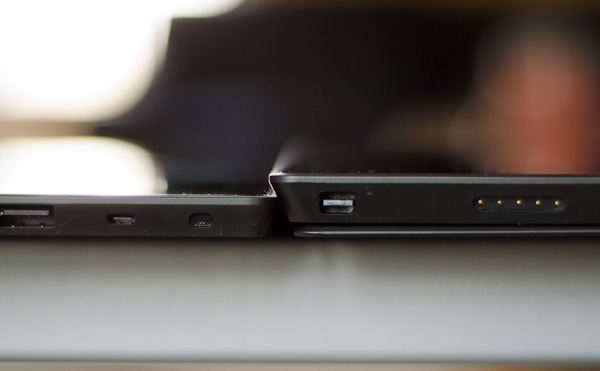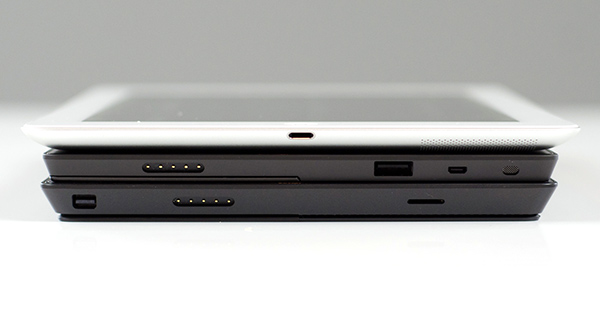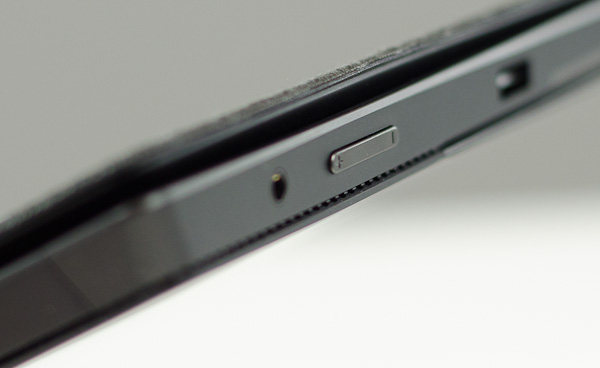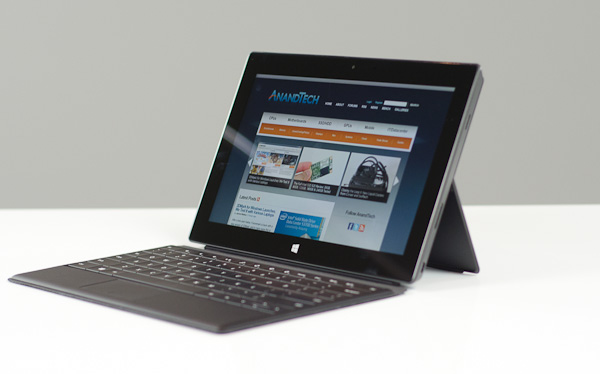Microsoft Surface Pro Review
by Anand Lal Shimpi on February 5, 2013 9:00 PM ESTSurface Pro Design
When I first saw Surface Pro, the Microsoft rep giving me the demo did a simple test. He stood Surface Pro right next to Surface, with the same start screen, and asked me if I could tell the two apart. The planar dimensions of Surface Pro are identical to Surface RT. Both feature the same sized 10.6-inch display, the same capacitive Windows button and the same 1-inch border around the screen. Looking head on, the only way you can tell the difference between Surface Pro and RT is the former’s 1080p display does make text a bit sharper.

Surface RT (left) vs Surface Pro (right)
Turn the two tablets to the side and the differences quickly become evident. Surface Pro is over 40% thicker than Surface RT (13.7mm vs 9.3mm). While the latter was of a similar thickness to an iPad with Retina Display, Surface Pro is clearly in a different league of dimensions.
The thickness of Surface Pro doesn’t really impede its portability, but the weight definitely makes it a lot less pleasant to carry around. Surface RT was already heavier than the competition but it hid its weight well. Surface Pro is just heavy for a tablet. I wasn’t originally impressed by the Surface RT form factor, but in switching between the RT and Pro models I immediately wish that Surface Pro came in the RT chassis and Surface RT came in something even thinner and lighter.

Surface Pro (left) vs. iPad 4 (right)

From top to bottom: iPad 4, Surface RT and Surface Pro
Shift the comparison to Ultrabooks however and all of the sudden Surface Pro seems quite light. It’s lighter than an 11-inch MacBook Air and Acer’s 11.6-inch Aspire S7 (although with optional keyboard cover it is heavier). It’s all about perspective. Compared to an iPad, Surface Pro is heavy, but compared to an Ultrabook or MacBook Air it’s light. The Pro model embodies the vision Microsoft had for the Surface family: to create a new type of device somewhere between a tablet and a notebook. That’s not to say there’s not room for improvement in the physical department. Surface Pro will likely go on a diet as it’s given more power efficient silicon, but even then you’ll always be able to build something thinner and lighter based on slower hardware, or go thicker and heavier with a notebook.
The fit and finish of Surface Pro are just as good as Surface RT. The tablet is built out of the same injection moulded Magnesium process (VaporMg) as Surface RT, however the chassis itself is somewhat simplified. While Surface RT featured three discrete VaporMg components (frame, back and kickstand), Surface Pro is made up of only two (single piece frame+back and kickstand). The result is no different to the end user, but the simplification on the assembly side is likely better for Microsoft.
I am fine laying the same praise on Surface Pro’s build quality as I did on Surface RT. The unique finish doesn’t feel like the aluminum we’re used to seeing on iPads, and definitely feels better than the plastic we’ve seen elsewhere. The VaporMg surface doesn’t feel like it would scratch easily, and after a few months with Surface RT I don’t see any visible scratches on my unit.
Surface Pro’s construction feels more utilitarian and understandably more oriented towards productivity, just like its little brother. I still believe that the Surface lineup is as much about Microsoft showing that it too can build high quality devices as it is about getting into the tablet market. If we compare it to the iPad, Surface Pro feels just as well built, if we compare it to every Windows RT and Windows 8 tablet or notebook on the market today - it’s worlds better. Say what you will about Microsoft entering the PC hardware business, but as of today Microsoft builds the best Windows RT and Windows 8 hardware on the market. If I ran a PC OEM I wouldn’t be angry at Microsoft, I’d be angry at myself for letting this happen.
Surface Pro retains the integrated kickstand from Surface RT, although the kickstand has been beefed up to accommodate the heavier tablet. Surface Pro’s kickstand keeps the device propped up at a fixed angle of 26-degrees away from the vertical axis. The rear facing camera is also angled to compensate (it shoots parallel to the ground with the kickstand opened).
The kickstand is allegedly good for over a million open/close cycles and it still doesn’t feel like something that would break. There are only two hinges in the kickstand compared to three for the RT model.
The kickstand on Surface Pro feels different than the kickstand on Suface RT. The Pro kickstand feels lighter and sounds less like metal and more like plastic if you tap on it. Feel around on the underside of the kickstand and you’ll notice a coating that seems to dampen sound and perhaps add some structure reinforcement to the design. Microsoft had to thicken the kickstand to support the added weight of the Surface Pro, but the difference is on the order of a fraction of a millimeter.
The tweaked kickstand does have different acoustics than Surface RT’s kickstand. While the latter sounded a lot like a thin metal door shutting, the Pro’s kickstand is far more muffled. I’d almost say it’s preferable.
Thankfully the kickstand’s functionality hasn’t been marginalized in the transition to the Pro. It’s still a highly integrated and very important part of the Surface experience. It’s simple to flip out and perfect for use on desks. You can make the kickstand work on your lap or chest if you’re lying down, but it’s not ideal for either unfortunately.
The more I use Surface (Pro and RT) the more I feel that Microsoft needs to pursue something a bit more flexible than the fixed 26-degree kickstand. The biggest issue by far is in-lap use with one of the keyboard covers attached. Depending on your seating position, the 26-degree angle that the kickstand opens at might be too small. Mechanically I don’t know the right solution for Microsoft but I do feel like for the kickstand to realize its true potential, it needs to be able to open and hold at multiple angles. It doesn’t necessarily need to have support for infinite angles, maybe even a few would work, but I do believe it’s necessary going forward.













228 Comments
View All Comments
powerarmour - Thursday, February 7, 2013 - link
I think you are missing the point...This is a Windows x86 product we are talking about here, something that we know will eat it's own disk space in temporary files and other junk.
Android and iOS are a 'lot' more frugal when it comes to data usage.
finbarqs - Wednesday, February 6, 2013 - link
I don't know what to expect... But it seems collectively, the surface has more bad reviews than good. In fact, anand wasn't even gung-ho about the device for the first half of the review. In fact, there are just the mentions of the limitation of what the surface is.So let's get one thing out of the way: battery life. average life I've read around the net is 3.5-4 hrs for regular usage -- which is probably worst than the yoga pad. Now i'm just thinking... doesn't the mbp have longer battery life then this? isn't the technology out there yet?
The surface would've been a different story if it had better battery, and came out with data plan enabled -- your favorite LTE carrier. This will make people turn heads more. I was excited to get one this weekend, but I've been put off by all the negative press...
Netscorer - Wednesday, February 6, 2013 - link
What did you expect from Ivy Bridge based design where battery has to be squeezed in the 10" tablet? I am actually quite surprised the battery results come in as high as being reported. 6 hours of browsing - that is very acceptable. 5 hours of video streaming is better then most ultrabooks on the market.nathanddrews - Wednesday, February 6, 2013 - link
This is a topic that I wish would get more attention. I've noticed screen tearing on nearly every Windows 7 and Windows 8 laptop when outputting to an external display, whether cloning or closing the lid. It doesn't seem to matter whether it's Intel, AMD, or NVIDIA graphics hardware or whether HDMI or VGA is used. Doesn't matter if hardware acceleration is enabled in the browser, the game, or video player, the tearing still occurs. The presence and application of Vsync doesn't seem to affect it either.The only consistent symptom is that it is sometimes worse than other times. I suspect that Windows desktop composition is to blame in some way, but I can't prove it.
dragonseer - Wednesday, February 6, 2013 - link
I was waiting for the surface pro, but decided to get the Vaio Duo 11 instead because of a few extra connection options, such as ethernet, HDMI, and I appreciate the backlit slider keyboard... Sporting the same processor and complete with a stylus, I was a mystified by your closing statement that "If you’re shopping for an Ultrabook today and want that tablet experience as well, Surface Pro really is the best and only choice on the market." ???Krysto - Wednesday, February 6, 2013 - link
How many times did you redo your battery tests before you got those results, Anand?You usually get lower battery results than everyone else. But now you got some of the highest, while everyone else puts it at like 4h, at most.
$1,000 for a device full of compromises, and thick and heavy as well is not worth it.
tipoo - Wednesday, February 6, 2013 - link
I find myself wishing the Surface design team would make a proper ultrabook. It could still be a tablet with a flip back screen like the Lenovo Yoga, just make the form factor an actual ultrabook rather than a tablet with a stand. That way they could integrate a better keyboard and mouse and potentially have a bit more room for battery and cooling.smalM - Wednesday, February 6, 2013 - link
"Once again, with lower power hardware I see Microsoft being able to minimize this - but that’s a topic for Surface 2 Pro."And it will have to compete with the successors of iPad 4 and Nexus 10.
"If you’re shopping for an Ultrabook today and want that tablet experience as well, Surface Pro really is the best and only choice on the market."
That's a really small market place.
BSMonitor - Wednesday, February 6, 2013 - link
Except, Ipad and Nexus can NEVER match a Microsoft tablet in one HUGELY important area for IT professionals, etc etc...x86 compatibility
Dekker - Wednesday, February 6, 2013 - link
> x86 compatibilityTrue, but that brings us to the core question: Is x86 compatibility a killer feature? I'm not convinced. Two reasons:
1) Given that x86 software relies heavily on a keyboard and mouse, it is hard to see how the tablet form factor is going to work. Stuff like building spreadsheets and editing large documents is just torture on a tablet (I have tried and tried). I immediately grab my laptop or MBA.
2) I use my tablet for browsing, email, casual gaming, light photo editing and internet shopping. All of these are easily done with apps, none of which require much investment in time, money or file conversion. In short, x86 is an irrelevance for many types of usage.
While I could see some future for the PRO as a corporate tablet, the lack of LTE/3G must surely be a deal breaker for many.